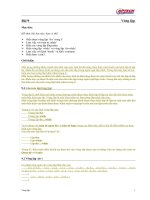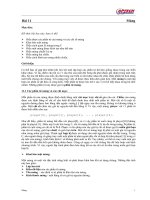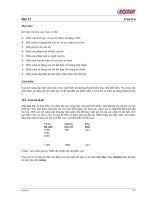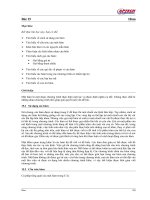Computer concept 2018 module09
Bạn đang xem bản rút gọn của tài liệu. Xem và tải ngay bản đầy đủ của tài liệu tại đây (1.89 MB, 85 trang )
Computer Concepts 2018
Module 9
Information
Systems
© 2019 Cengage. All rights reserved.
Module Contents
•
•
•
•
•
Section A: Information System Basics
Section B: Enterprise Applications
Section C: Systems Analysis
Section D: Design and Implementation
Section E: System Security
© 2019 Cengage. All rights reserved.
Section A: Information Basics
•
•
•
•
•
Enterprise Basics
Transaction Processing Systems
Management Information Systems
Decision Support Systems
Expert Systems
© 2019 Cengage. All rights reserved.
Section A: Objectives (1 of 2)
• Explain the relationship between an organization, its
mission, and its information system
• Provide examples of vertical and horizontal market
applications
• Match strategic, tactical, and operational planning
needs to employees at each level of an organizational
chart
© 2019 Cengage. All rights reserved.
Section A: Objectives (2 of 2)
• Describe three classifications of problems
• Describe the characteristics of TPS, MIS, DSS, and
expert systems
• Use the terms decision model and decision query in a
sentence
• Explain how fuzzy logic is used by expert systems
© 2019 Cengage. All rights reserved.
Enterprise Basics (1 of 6)
• An information system collects, stores, and processes
data to provide useful, accurate, and timely information,
typically within the context of an organization
• An organization is a group of people working together
to accomplish a goal
• Any organization that seeks profit by providing goods
and services is called a business or an enterprise
• An organization’s goal or plan is referred to as its
mission; its mission statement describes not only an
organization’s goals, but also the way in which those
goals will be accomplished
© 2019 Cengage. All rights reserved.
Enterprise Basics (2 of 6)
© 2019 Cengage. All rights reserved.
Enterprise Basics (3 of 6)
• Vertical market software is designed for a specific
industry or enterprise; the software that controls
touchscreen order entry at fast-food restaurants is an
example of software designed for vertical markets
• Horizontal market software is designed for common
elements of many businesses
© 2019 Cengage. All rights reserved.
Enterprise Basics (4 of 6)
• An organizational chart depicts the hierarchy of employees
in an organization
• Workers are the people who directly carry out the
organization’s mission
• Managers determine organizational goals and plan how to
achieve those goals; managers use the following methods:
– Strategic planning – emphasis on long-range and future goals
– Tactical planning – setting incremental goals that can be
achieved in a year or less
– Operational planning – covers activities that make day-to-day
operations run smoothly
© 2019 Cengage. All rights reserved.
Enterprise Basics (5 of 6)
© 2019 Cengage. All rights reserved.
Enterprise Basics (6 of 6)
• All can be classified into three types: structured, semi-structured,
and unstructured
TYPE OF PROBLEM
EXAMPLES
METHODOLOGY
A structured problem is an everyday, run-of-the-mill,
routine problem. When you make decisions in
response to structured problems, the procedure for
obtaining the best solution is known, the objective is
clearly defined, and the information necessary to
make the decision is easy to identify.
Which customers
should receive
over-due
notices?
The information for this decision is usually
stored in a file cabinet or computer system.
The method for reaching a solution is to look
for customers with outstanding balances, and
then check whether the due dates for their
payments fall before today’s date.
A semi-structured problem has a known procedure
for arriving at a solution; however, the process
might involve some degree of subjective judgment.
Also, some of the information regarding the
problem might not be available, might lack
precision, or might be uncertain.
How many
mountain bikes
should a store
stock for the
holidays?
The decision can be based on the previous
year’s sales; but because future consumer
spending is uncertain, determining the
appropriate amount of holiday inventory might
require some guesswork.
An unstructured problem requires human intuition
as the basis for finding a solution. Information
relevant to the problem might be missing, and few
parts of the solution can be tackled using concrete
models. If experts are presented with a problem but
they disagree on a solution, it is likely an
unstructured problem.
Should Saks
Fifth Avenue
stock Japaneseinspired evening
gowns?
The purchasing agent for women’s clothing
makes this decision based on her intuition of
customer taste and fashion trends.
© 2019 Cengage. All rights reserved.
Transaction Processing Systems (1 of 2)
• In an information system context, a transaction is an
exchange between two parties that is recorded and stored in
a computer system
• A transaction processing system (TPS) provides a way to
collect, process, store, display, modify, or cancel transactions
• Transaction processing systems, such as banking, use
online processing—a real-time method in which each
transaction is processed as it is entered; this system
software is often referred to as an OLTP (online transaction
processing) system
• Detail reports provide a basic record of complete
transactions
© 2019 Cengage. All rights reserved.
Transaction Processing Systems (2 of 2)
•
A transaction processing system is characterized by its ability to:
– Collect, display, and modify transactions
– Store transactions
– List transactions
© 2019 Cengage. All rights reserved.
Management Information Systems (1 of 2)
• The term management information system refers to
any computer system that processes data and provides
information within a business setting
• Managers depend on these reports to make routine
business decisions
• A summary report combines, groups, or totals data
• An exception report contains information that is
outside of normal or acceptable ranges
© 2019 Cengage. All rights reserved.
Management Information Systems (2 of 2)
A management information system is characterized by its
ability to:
•
•
•
•
Produce routine and on-demand reports
Provide useful information for managerial activities
Increase managerial efficiency
Provide information used for structured, routine decisions
© 2019 Cengage. All rights reserved.
Decision Support Systems (1 of 3)
• A decision support system (DSS) helps people make
decisions by directly manipulating data, accessing data
from external sources, generating statistical projections,
and creating data models of various scenarios
• An executive information system (EIS) is a type of
decision support system designed to provide senior
managers with information relevant to strategic
management activities
© 2019 Cengage. All rights reserved.
Decision Support Systems (2 of 3)
• A decision model is a numerical representation of a
realistic situation, such as a cash-flow model of a
business that shows how income adds to cash accounts
• A decision query is a question or a set of instructions
describing data that must be gathered to make a
decision
© 2019 Cengage. All rights reserved.
Decision Support Systems (3 of 3)
© 2019 Cengage. All rights reserved.
Expert Systems (1 of 4)
• An expert system, sometimes referred to as a
knowledge-based system, is a computer system
designed to analyze data and produce a
recommendation, diagnosis, or decision based on a set
of facts and rules
• The facts and rules are incorporated into a knowledge
base that is stored in a computer file and can be
manipulated by software called an inference engine
• The process of designing, entering, and testing the
rules in an expert system is referred to as knowledge
engineering
© 2019 Cengage. All rights reserved.
Expert Systems (2 of 4)
© 2019 Cengage. All rights reserved.
Expert Systems (3 of 4)
• An expert system shell is a software tool containing an
inference engine and a user interface that developers
use to enter facts and rules for a knowledge base
• These systems are designed to deal with data that is
imprecise or problematic; using a technique called
fuzzy logic, an expert system can deal with this type of
data by working with confidence levels
© 2019 Cengage. All rights reserved.
Expert Systems (4 of 4)
© 2019 Cengage. All rights reserved.
Section B: Enterprise Applications
•
•
•
•
Ecommerce
Supply Chain Management
Customer Relationship Management
Enterprise Resource Planning
© 2019 Cengage. All rights reserved.
Section B: Objectives
• Provide at least two examples of businesses that
engage in each of the following types of ecommerce:
B2C, B2B, C2C, and B2G
• List the cookie-related events that occur during an
online shopping session
• Explain how just-in-time inventory is related to SCM
• Draw a diagram of a supply chain
• Describe how loyalty programs are related to CRM
• List the six major components of an ERP application
• List at least five benefits of ERP systems
© 2019 Cengage. All rights reserved.
Ecommerce (1 of 3)
•
Ecommerce refers to business transactions that are
conducted electronically over a computer network
© 2019 Cengage. All rights reserved.









